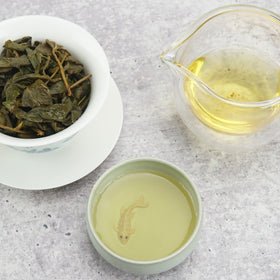What is Pu erh Tea? Part 1 - Sheng and Shou
This is first of a 4 part series on Pu-erh tea.
Pu-erh tea is fermented and aged tea that comes in a compacted form. Produced exclusively in Yunnan, the South-Western province of China, the tea is produced in two broad styles - raw (sheng), and ripe (shu). Sheng pu-erh is left to ferment naturally, while the fermentation in ripe or shu pu-erh is done in controlled factory settings.
Sheng Pu-erh Tea
Raw pu-erh has a lighter body with flavors that can be earthy, floral, vegetal, herbaceous, astringent, and sweet. The character of a ripe pu-erh, however, is dramatically different. The body is heavy and flavors are rich, with dark notes of earth, leather, cacao, and mushroom.
The processing of pu-erh starts with the plucking of new leaves from tea bushes. The finest crop includes the "terminal" buds of the leaf (the youngest leaf shoots that are yet to open) and the leaves surrounding it. The fresh leaves are then brought to the factory where they are first withered indoors. The withered leaves are then tossed in heated woks to remove whatever moisture is left. This process also called "kill green" prevents the leaves from oxidizing when they are rolled.
Rolling the leaves brings the natural oils of the tea leaf out, as well as shaping them. After rolling, the tea is set out in the sun to dry. Up to this point, the processing is very similar to the production of green tea. Once the leaves are dry, they are now ready to be pressed into cakes.
The dry leaves are weighed - 357 grams for a standard size cake - and steamed in a linen bag. The leaves become limp upon steaming, and the linen bag is then tightened around it. This tight ball of tea is then put into a mold and pressed down with a heavy stone weight. Once the tea is sufficiently compressed, the bag is removed and the cake is set on a rack to air dry. This tea cake is now ready for fermentation and aging, a process that never ceases as long as the conditions are right. As the tea ages it acquires more depth, developing more mellow and redolent flavors.
Shu Pu-erh Tea
Shu or ripe pu-erh follows similar steps in production except before pressing of the cakes the leaves are moistened and kept in a large covered pile. This "wet-piling method" can last two-three months during which time the resulting heat and moisture trapped in the mass results in a deep fermentation of the leaves. Technically, this is considered to be a more challenging to make than sheng pu-erh.
While sheng dates back centuries, the method of making shu pu-erh developed only in 1973. The objective was to accelerate the fermentation, so that consumers did not have to wait for long periods - in some cases up to 10 years - before they could start drinking sheng pu-erh. The latter would be too bitter and harsh if not aged adequately. However, these days manufacturers are producing raw puerh that is fine enough to be consumed within a year or so of production.
Personal Preference
Which tea you would choose to drink - sheng or shu - is entirely upon your preference. While I have seen people stick to one or the other, there are also some tea enthusiasts who enjoy both of them equally. Personally, I am more inclined towards shu puerh. I enjoy its crisp, light body with earthy flavor and a balance of astringent and spring honey notes.
But I also enjoy at times the dark, heavy cup that a shu makes. I find it particularly invigorating on cold dark days or as in the evenings while signing off the day.
I have also recommended shu pu-erh to those who are looking to switch from coffee to tea with a fairly great deal of success. Coffee drinkers seem to enjoy the full body richness of the shu puerh.
If you are new to pu-erh I would advise you start with the shengs. Its lighter body and taste notes are more easier on a new palate. Once you are comfortable with that you can try the darker shus.
If you have any questions and comments about pu-erh please leave them in the comments below.








